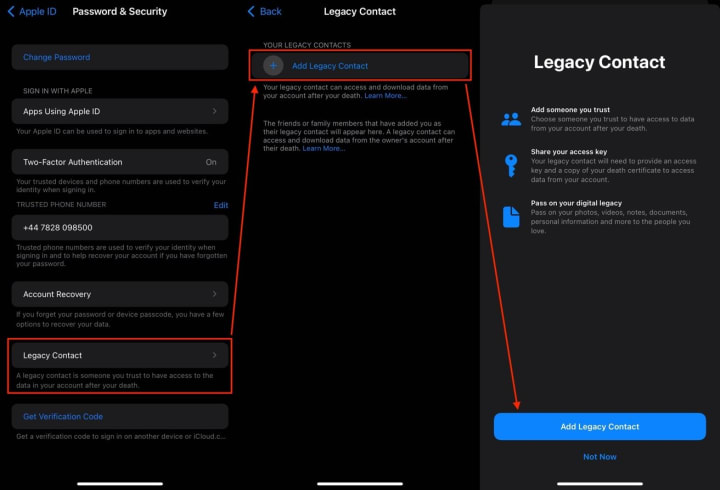The days of privacy are few and far between for those of us who own a phone, computer and any other electrical device.
When a loved one dies, the necessary arrangements must occur, but what about if most of those items consist of hundreds of terabytes saved over different electronic devices & online?
Usually, the process would require lawyers and lengthy approval processes (as well as thousands of dollars). It almost seems too hard.
Right now, there are several platforms building tools to let you indicate what should happen to your accumulation of digital, in the event of your death.
Of course, Apple is the most recent to take charge of this matter, and they rolled out their Digital Legacy Feature last month.
Within the privacy settings of your Apple device, you are free to nominate a “Legacy Contact” who will receive a unique code.
If you pass away, they can send this particular code with your death certificate to Apple.
This entitles them to access everything you have stored in iCloud; Including documents, files, contacts, mail, health data, memos, anything you have backed up and much more.
Unfortunately, at the moment, you can’t choose what piece of data goes to specific people or hide anything that may be considered “private.” Apple has made it simple so that the person you nominate gets everything on the iCloud.
Apple created this feature as a tool to remove some of the barriers loved ones might face (and probably did in the past) in proving the validity of their claim in receiving loved ones digital assets.
The only limits loved ones might face are your passcodes, protected by encryption on each device.
Unfortunately, no one can break into the device without knowing this, despite being a legacy contact.
Your best bet is to wipe the devices clean and then re-importing the data back in from the cloud. However, you could still lose valuable information and data stored on the device this way.
Save all of your passwords and codes to get into specific apps in a safe place that only your next of Kin will be able to find -when the time is necessary.
When it comes to items like DVD’s or books, you will run into the apple digital wall with this one. They won’t allow legacy contacts to access these items (including books, apps and games).
If you would like to take this one step further & cover all your digital bases, other tech giants offer specific legacy programs too.
Here is how you can access the function on your iMac, iPad or iPhone.

Google, for instance, has its inactive account manager.
This doesn’t require much red tape to access but must give the necessary instructions about when the system begins (perhaps a period after you haven’t used your account).
You can also provide direct instructions on who accesses what and anything you wish to delete from prying eyes.
Facebook memorialises an account when someone dies, leaving the profile and accumulated media online for people to see.
In the settings, you can nominate to have your account deleted when you die or appoint a legacy contact who will have limited control.
They can download everything you have uploaded, but not private messages.
LinkedIn, Instagram and Twitter will delete the account at the hands of a next of kin or executor.
Don’t worry; those platforms will now allow anyone to access your log-in details.
Microsoft has nothing right now. It just deletes your account when you have been inactive for two years.
Hopefully, they will start to catch onto the digital legacy trend before it’s too late!
Takeaways
Death is just as much of a significant event as the birth of a new baby.
Although we don’t want to face the reality that we will eventually die, it’s essential to have the necessary plans to make it less stressful for those left behind.
A digital footprint is just one part — if not an essential part of our lives that holds many loving memories of our life, children and anything else that is significant to us. It would be a shame to lose them.
Photos and videos taken over the years are some of the last memories we will have of loved ones long gone.
Please note: It’s a requirement to download iOS 15.2 or iPadOS 15.2, as well as turn on your two-factor authentication to access the Legacy feature.
If you have parents with Apple devices, help them through the process of doing so.
Something to think about, but something we all need to do sooner rather than later
About the Creator
Ange Dim
My mission is to help people become the best version of themselves through nutrition, exercise and mindset. Get your dose of coaching every week here: https://anged.substack.com/subscribe







Comments
There are no comments for this story
Be the first to respond and start the conversation.